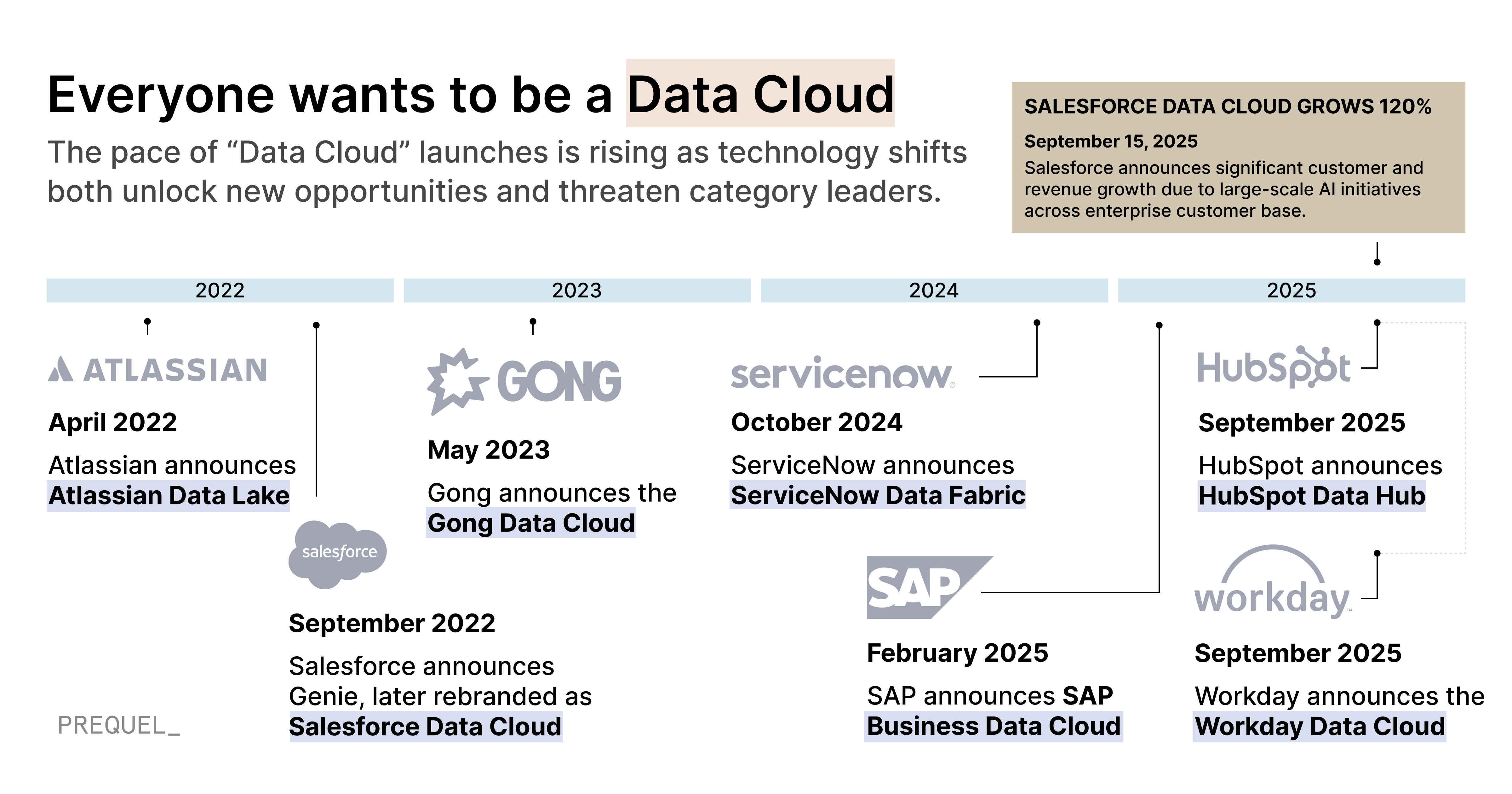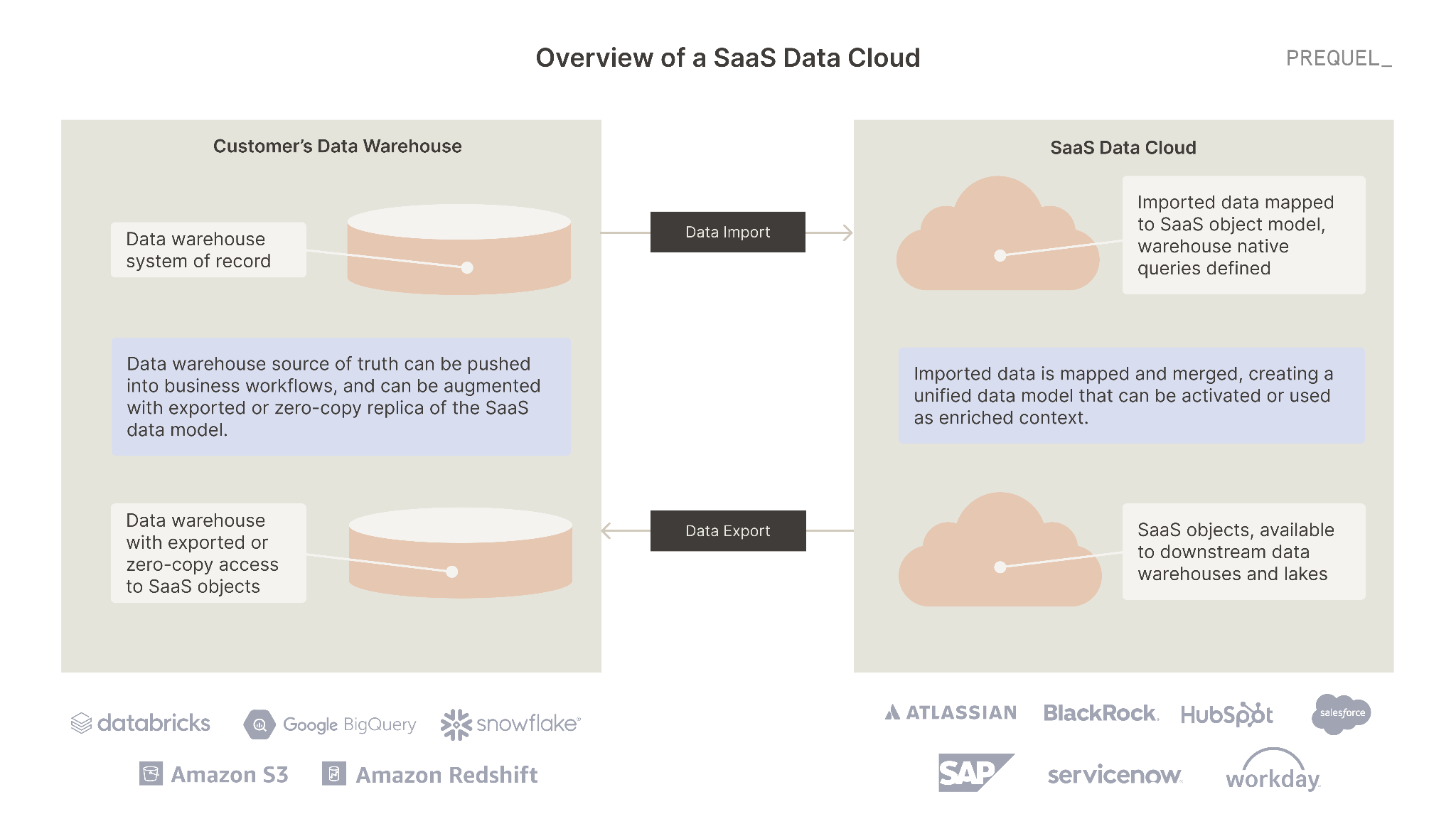Everyone wants to be a Data Cloud

In September, Salesforce revealed that Salesforce Data Cloud run-rate is now over $1.2B ARR and growing 120% year over year (the company's fastest growing home-grown product, ever). In the same month, Workday and HubSpot both introduced their own takes on the concept: Workday Data Cloud (announced September 16 at Workday Rising) and Hubspot Data Hub (announced September 3 at INBOUND).
"Data Clouds" are emerging as a major product focus for enterprise software and a key component of their AI platform strategies — evidence of both a massive opportunity and an existential threat to the incumbent SaaS leaders.

What is a Data Cloud?
A "data cloud" is converging on a common set of features: connections to existing sources of truth, semantic mapping and governance to make the data usable by apps and AI, and access to that same data in other platforms.

Key components of a Data Cloud:
- Importing data from existing sources of truth. Connecting to core data lakes and warehouses, objects, and third-party tools; mapping objects to the application data model; ingesting or "syncing" into the transactional system of record.
- Adding AI & Intelligence. Activating connected data using in-app tools; using data for AI agent/copilot context.
- Exporting, or "zero copy", data access from other systems. Enabling querying from or sharing to other data platforms (such as Snowflake, Databricks, BigQuery, AWS, and others). Supporting near real-time analysis of data in downstream systems.
Why now: the data technology
First, the recent innovation and widespread adoption of open table formats has made interoperable data clouds technically feasible. Iceberg and Delta tables (supported by some data clouds e.g. Salesforce, Workday, Atlassian) mean that shared datasets can be exposed in a single format on object storage, and queried by any compatible downstream query engine. For the first time, broad support of these new open table formats unlock new cross-enterprise data architectures without loss in performance.1
Why now: the AI opportunity
But the most obvious tailwind is AI: as both the biggest opportunity and realest existential threat. For incumbents, the advantage is obvious: as the system of record and data sources of truth for their customers, they are best positioned to centralize even more of the data and layer AI products directly on top.
But the same force cuts the other way. AI-native entrants are unencumbered by legacy, and they will chip away at entrenched workflows if incumbents fail to operationalize AI to the level their customers expect (or as quickly as new entrants are attempting). For the public companies, every earnings cycle hints at the market’s judgement on whether AI is proving to be a growth opportunity or a disruptive threat.
In this environment, a Data Cloud is no longer optional. Thanks to AI, it has become table stakes: you must participate just to keep your place.
How the data platforms (Databricks & Snowflake) are involved
Beneath the application layer, the launch of all of these "data clouds" could be interpreted as a competitive threat to the leading data platforms. However, the primary use cases and product capabilities don't overlap significantly and the relationship is more symbiotic in nature. The Salesforce Data Cloud FAQs have this to say about it:

In reality, this is the productization of an architecture that most enterprises use already: SaaS applications for core business-user workflows and tools, data platforms for executive reporting, engineering, and analytics, and a bidirectional connection (zero-copy or not) between the two.
Some immediate winners in this trend are the major data warehouses2, most notably, Snowflake and Databricks, who are both earning significant comarketing and product partnership with every launch.
What it means to be a next-gen enterprise application
For enterprise SaaS, Data Clouds mark the first phase in redefining what it means to be a next-generation SaaS platform. The winners will be those that leverage their Data Cloud for more than just storage, but as a data activation layer—where AI agents can orchestrate and act across a substrate of connected data and domain workflows.
The stakes have never been higher: the successful productization of connected data, semantics, and AI-driven workflows will define the next decade’s category leaders and could consign the rest to obsolescence.
Disclaimer: Prequel powers some of the Data Clouds highlighted in this post.
1We wrote about how fast Iceberg is on Snowflake.
2As two examples, the SAP Business Data Cloud is closely aligned with Databricks, and the BlackRock Data Cloud is explicitly powered by Snowflake. A future blog post may explore the competition among Snowflake and Databricks among the SaaS Data Clouds.













